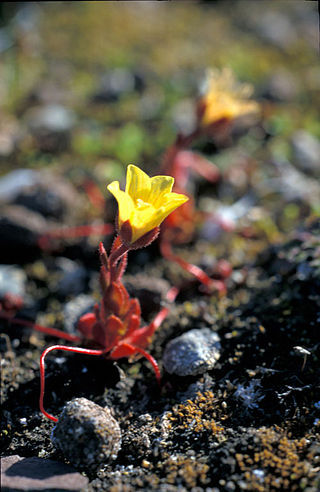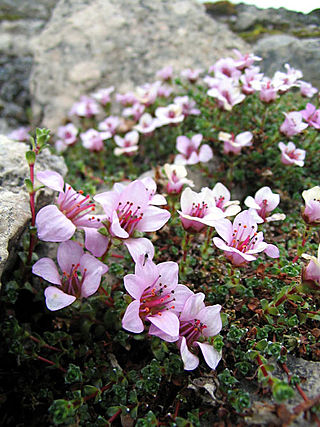
Saxifraga is the largest genus in the family Saxifragaceae, containing about 465 species of holarctic perennial plants, known as saxifrages or rockfoils. The Latin word saxifraga means literally "stone-breaker", from Latin saxum + frangere. It is usually thought to indicate a medicinal use for treatment of urinary calculi, rather than breaking rocks apart.

Saxifraga flagellaris, the whiplash saxifrage or flagellate saxifrage, is a plant native all over the Eurasian Arctic Coast, Siberia, Far East, Caucasus and some areas of northern Rocky Mountains. It is not very common. It is also known as spider saxifrage or "spider plant", though the latter name more commonly refers to the unrelated Chlorophytum comosum (Agavaceae).

Saxifraga oppositifolia, the purple saxifrage or purple mountain saxifrage, is a species of plant that is very common in the high Arctic and also some high mountainous areas further south, including northern Britain, the Alps and the Rocky Mountains.

Saxifraga cespitosa, the tufted alpine saxifrage or tufted saxifrage, is a flower common to many arctic heights. It appears further south in mountainous areas of the Alps, Norway, Scotland, Wales, Iceland, Siberia, western North America and Greenland.

Saxifraga paniculata is an alpine species of flowering plant in the saxifrage family, with native distribution in the temperate northern hemisphere. Common names include alpine saxifrage, encrusted saxifrage, lifelong saxifrage, lime-encrusted saxifrage, livelong saxifrage, white mountain saxifrage, and silver saxifrage.

Saxifraga stolonifera is a perennial flowering plant known by several common names, including creeping saxifrage, strawberry saxifrage, creeping rockfoil, Aaron's beard, mother of thousands, roving sailor, and strawberry begonia or strawberry geranium.

Primula pauciflora, the pretty shooting star, few-flowered shooting star, dark throat shooting star or prairie shooting star, is a species of flowering plant in the primula family Primulaceae. It is a widespread and very variable species, native to western North America, from Subarctic America to Mexico, often in xeric and desert habitats. It is found in the Great Basin Deserts and Mojave Desert. Its synonyms include Dodecatheon pauciflorum and Dodecatheon pulchellum.

Micranthes nivalis is a plant species in the saxifrage family. It is commonly called snow saxifrage or (ambiguously) alpine saxifrage.

Felicia aethiopica is a low shrublet of up to about 50 cm high that is assigned to the family Asteraceae. It has rigid, leathery, inverted egg-shaped leaves, with only the lowest pair set oppositely. It has flower heads with an involucre of about 8 mm in diameter with bracts that each contain three resin ducts, and have one whorl of twelve to fourteen ray florets with about 11 mm long and 1½ mm wide blue straps surrounding many yellow disc florets. The plant is called wild aster or dwarf Felicia in English, and wilde-aster or bloublombossie in Afrikaans. Flowering occurs year-round. Wild aster can be found in the Western and Eastern Cape provinces of South Africa.

Madia glomerata is a species of flowering plant in the family Asteraceae known by the common name mountain tarweed.

Micranthes bryophora is a species of flowering plant known by the common name bud saxifrage. It is native to the western United States, where its two varieties are geographically separated. The more common var. bryophora is endemic to the mountains of California, and the rare var. tobiasiae is known only from the Payette National Forest of western Idaho.

Micranthes ferruginea is a species of flowering plant known by the common names russethair saxifrage and rusty saxifrage. It is native to western North America from Alaska and northwestern Canada to northern California to Wyoming, where it can be found in moist, rocky habitat in mountainous areas. It is a perennial herb growing from a caudex and rhizome system and producing a basal rosette of leaves. Each leaf is up to 6 centimeters long, thick and fleshy with large teeth along the edges. The inflorescence arises on a slender, hairy peduncle up to 40 centimeters tall. Thin branches bear flowers and reproductive bulbils. Each flower has spade-shaped white petals, the upper ones dotted with gold.

Micranthes integrifolia is a species of flowering plant known by the common name wholeleaf saxifrage. It is native to western North America from British Columbia to Montana and northern California, where it grows in moist habitat, including meadows, prairies, and grassy mountain slopes. It is a perennial herb growing from a caudex and system of rhizomes, and producing a basal rosette of leaves. Each leaf is up to 7 centimeters long with a toothed or smooth-edged blade borne on a short petiole. The inflorescence arises on a stout, hairy peduncle up to 35 centimeters tall. White-petaled flowers occur in a cluster or dense array at the top.

Micranthes odontoloma is a species of flowering plant known by the common name brook saxifrage. It is native to much of western North America, where it can be found in many types of moist and rocky habitat types. It is a perennial herb. It produces a clump of leaves with rounded, toothed, or scalloped blades on long, thin petioles. The branching inflorescence arises on a slender, erect peduncle up to half a meter tall bearing many flowers. Each flower has five teardrop-shaped white petals with threadlike bases, and stamens with flat, narrow filaments that sometimes resemble additional petals.

Micranthes oregana is a species of flowering plant known by the common name Oregon saxifrage. It is native to western North America, including the mountainous regions of the western United States. It can be found in moist habitat, such as marshes and other wetlands. It is a perennial herb growing from a thick, fleshy or woody caudex. It produces a basal rosette of linear to lance-shaped leaves each up to 25 centimeters long. The inflorescence arises on a stout peduncle which may exceed a meter in height. It is topped with one or more dense clusters of white-petaled flowers.

Micranthes tolmiei is a species of flowering plant known by the common name Tolmie's saxifrage, or Tolmie's alpine saxifrage. It is native to western North America from Alaska to Montana to California, where it grows in rocky mountain habitat types, especially in alpine climates, such as talus and fellfields. It is a small perennial herb growing in mats of creeping stems lined with thick, fleshy leaves each up to 1.5 centimeters long. The inflorescence arises on a stout, erect peduncle with a few stubby bracts midway up. The flowers have narrow white petals and petal-like white stamens.
Saxifragopsis is a monotypic genus of flowering plants in the saxifrage family containing the single species Saxifragopsis fragarioides, which is known by the common name strawberry saxifrage. This plant is sometimes included in genus Saxifraga. It is native to the northwestern United States, where it is mostly limited to the Klamath Mountains of southern Oregon and northern California, with some disjunct occurrences known from Washington. It grows in rocky mountain habitat, such as talus. This is a mat-forming perennial herb growing from a thick, woody caudex and system of rhizomes. Leaves are mostly located at ground level, the toothed oval blade attached to the long petiole by a joint and easily broken off. Smaller, reduced leaves are located along the stem. The inflorescence arises on an erect, hairy, glandular peduncle and is made up of many small clusters of white-petaled flowers.

Saxifraga bryoides is a species of saxifrage known by the common name of mossy saxifrage. In German it is known as Moosartiger Steinbrech. It is an inhabitant of the Alps and other mountain ranges at high altitudes in continental Europe.

Micranthes is a genus of flowering plants in the saxifrage family. It was formerly included within the genus Saxifraga until recent DNA evidence showed the members of what is now Micranthes are more closely related to Boykinia and Heuchera than to other members of the genus Saxifraga.

Micranthes californica, known by the common name California saxifrage, is a species of flowering plants.



















